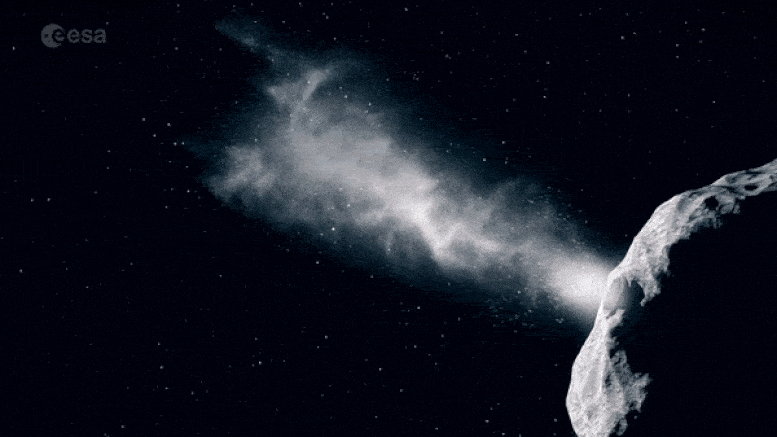NASA’nın DART uzay aracı, Eylül 2022’de Didymos ikili asteroit sisteminin daha küçük gövdesiyle çarpışacak. Kredi: ESA–ScienceOffice.org
<span class="glossaryLink" aria-describedby="tt" data-cmtooltip="
” data-gt-translate-attributes=”[{” attribute=””>NASA’s Double Asteroid Redirection Test (DART) spacecraft recently acquired its first image of Didymos, the double-asteroid system that includes its target, Dimorphos. DART will intentionally smash into Dimorphos, the asteroid moonlet of Didymos, on September 26. Although the asteroid poses no threat to Earth, this is humanity’s first test of the kinetic impact technique, using a spacecraft to deflect an asteroid for planetary defense.
This image (below) of the light from asteroid Didymos and its orbiting moonlet Dimorphos is a composite of 243 images taken by the Didymos Reconnaissance and Asteroid Camera for Optical navigation (DRACO) aboard DART on July 27, 2022.
From this distance—about 20 million miles away from DART—the Didymos system is still very faint, and navigation camera experts were uncertain whether DRACO would be able to spot the asteroid yet. However, once the 243 images DRACO took during this observation sequence were combined, the team was able to enhance it to reveal Didymos and pinpoint its location.

This image of the light from asteroid Didymos and its orbiting moonlet Dimorphos is a composite of 243 images taken by the Didymos Reconnaissance and Asteroid Camera for Optical navigation (DRACO) aboard DART on July 27, 2022. Credit: NASA JPL DART Navigation Team
“This first set of images is being used as a test to prove our imaging techniques,” said Elena Adams. She is the DART mission systems engineer at the Johns Hopkins Applied Physics Laboratory (APL) in Laurel, Maryland. “The quality of the image is similar to what we could obtain from ground-based telescopes, but it is important to show that DRACO is working properly and can see its target to make any adjustments needed before we begin using the images to guide the spacecraft into the asteroid autonomously.”
A number of navigation simulations using non-DRACO images of Didymos have already been conducted by the team. However, DART will ultimately depend on its ability to see and process images of Didymos and Dimorphos, once it too can be seen, to guide the spacecraft toward the asteroid, especially in the final four hours before impact. At that point, DART will need to autonomously self-navigate to impact successfully with Dimorphos without any human intervention.
NASA’nın Pasadena, California’daki Jet Propulsion Laboratuvarı’nda DART navigasyon lideri Julie Bellerose, “Didymos’un DRACO görüntülerini ilk kez gördüğümüzde, DRACO için en iyi ayarları düzenleyebilir ve yazılımda ince ayar yapabiliriz” dedi. “Eylül ayında, Didymos’un yerini daha kesin bir şekilde belirleyerek DART’ın hedeflediği yeri hassaslaştıracağız.”
DART ekibi, her beş saatte bir alınan gözlemleri kullanarak, önümüzdeki üç hafta boyunca üç yörünge düzeltme manevrası gerçekleştirecek. Bunların her biri, uzay aracının gerekli yörüngesinin çarpması için hata payını daha da azaltacaktır. 25 Eylül’deki son manevradan sonra, çarpmadan yaklaşık 24 saat önce, navigasyon ekibi 2 kilometre (1.2 mil) içindeki hedef Dimorphos’un konumunu bilecek. Oradan, DART, asteroit aycıkını durdurmak için kendi kendine rehberlik etmek için kendi başına olacak. DART, Dimorphos’a saniyede 4 mil (7 kilometre) hızla çarpacak.
DRACO, daha sonra 12 Ağustos, 13 Ağustos ve 22 Ağustos tarihlerinde planlanan gözlemler sırasında Didymos’u gözlemledi.
Johns Hopkins Uygulamalı Fizik Laboratuvarı (APL), ajansın Gezegensel Görevler Program Ofisinin bir projesi olarak NASA’nın Gezegensel Savunma Koordinasyon Ofisi için DART görevini yönetiyor. DART, uzaydaki hareketini biraz değiştirmek için kasıtlı olarak Dimorphos’a kinetik bir etki uygulayan dünyanın ilk gezegen savunma testi görevidir. Asteroit Dünya için herhangi bir tehdit oluşturmazken, DART görevi, bir uzay aracının nispeten küçük bir asteroit üzerinde kinetik bir etkiye özerk olarak gidebileceğini gösterecek ve bunun, Dünya ile çarpışma rotasında bir asteroidi saptırmak için uygun bir teknik olduğunu kanıtlayacaktır. hiç keşfedilir. DART, 26 Eylül 2022’de hedefine ulaşacak.

